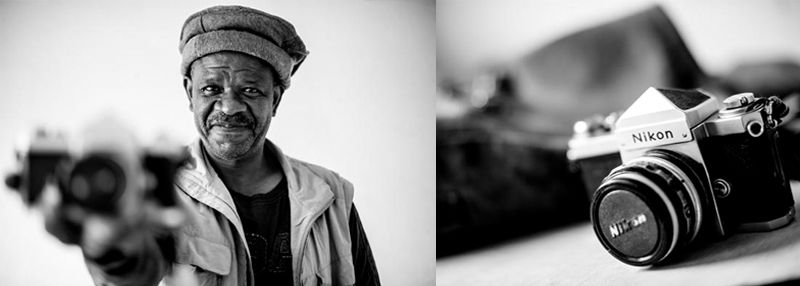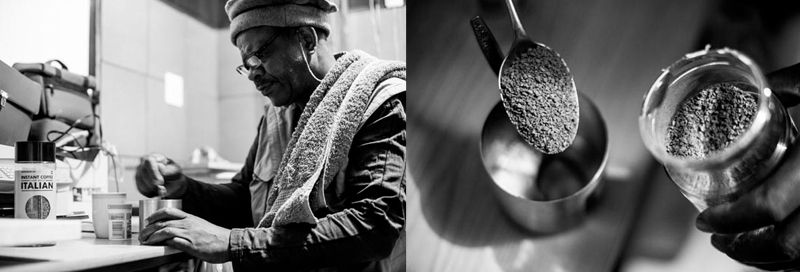First published in the Coffee Magazine 10th Edition
Words By
Jazz Kuschke
Images by
Craig Kolesky
“I haven’t taken a good photograph yet,” jokes Victor Matom. The 54-year-old photographer from Orlando West laughs easily. “A good one is still in my brain somewhere,” he says. “It’s a work in progress, it’s still coming. There are certain ones I’ve taken that I love, but I think that’s why I am still shooting… If I had taken a ‘great’ one I most probably would’ve given up.”
He’s not seeking affirmation or praise – as so many do – by his self-depreciation, it’s pure honesty. A truthfulness born from a deep understanding of his art. That, and perhaps the long journey he’s walked with the craft, a road which, about two years ago, brought him to processing film using coffee.
 Art by necessity
Art by necessity
Matom got into photography as much by chance as necessity. As one of eight children he was raised by his grandmother in Soweto. “I come from a very poor family,” he explains. “She (my grandmother) was a washer women and got about R5 a week. I had to do something to augment her salary…” So, Matom and his friends used to fill up the potholes in Soweto and then ask passing motorists for a few coins. “Of course, when it wasn’t raining we had no work to do and the motorists would get tired of us, as there weren’t many cars in Soweto at all in those days,” he says.
Having saved just a little bit of money, Matom decided to buy himself a small point-and-shoot camera. “I read a few books and that was the start of my photographic journey,” Matom says. He began taking pictures of his friends, shooting weddings and small community functions and soon become known as ‘the photographer’.
“I used to walk to Kliptown to take my film in and then go collect it the following week, soon I was making more than my grandmother… I paid my school fees and helped my family.”
Just using it to get by was far from good enough for him though and from early on he pursued the artistic side of making photos. “I knew that to be a good photographer required a lot of education and that I needed to understand photography as an art from,” he says. “So I started reading more and learning more, educating myself.”
“Then, 1976 I was inspired by the pictures I saw in the newspapers, especially of the uprisings. I thought maybe that was the journey I should take, telling stories. With photographs the story remains.” In this manner Matom self-taught himself to the point where he began teaching others.
“I realised that there was a need in the community to keep our children occupied. We have seen that if they get bored they get up to no good. So I approached the community leaders and offered to teach these children photography.” At the same time Matom was freelancing for various local newspapers and became an international correspondent for US News and World Report and did a lot of work for Time & Life magazine.
Life inspires me, I like to see happy people. In my photographic journey it’s books that inspires me, I like to see what other people are doing so that I don’t fall behind.
Today he has a photography school called Sifikile (‘we have arrived’), built with the help of a Japanese organisation and some of the children he first taught under a tree are now highly respected photojournalists.
Matom has travelled, exhibited and lectured around the world. His work is widely published and he continues to teach youths from his community to depict their situation in an artistic way. He’s evolved into the digital photography age, yet he hasn’t lost touch with his analog roots and is continuously studying his craft.
Coffee processing
“I was in France about two years ago at a conference where there were about 100 photographers and someone was talking about it,” he says, of the alternative to using regular (and more expensive) darkroom chemicals. “I googled it up when I came home and started playing around.”
According to Matom there are various recipes available online, but no real specifics and they all differ. “What happens is that different countries have different coffee and different soap and different measurements,” he explains. “They talk about a teaspoon, but a teaspoon can vary in size anyway. There was no specific recipe with millilitres and so on, so for the past two years I’ve played around trying to develop my own way.”

This alternative processing method has been credited to a Dr. Scott Williams and his class at the Rochester Institute of Technology in America, where, some two decades ago they experimented to find a household developer. To radically transcribe the chemistry - coffee is required, along with sodium carbonate, vitamin C and a fixer.
What Matom’s ‘own way’ calls for is pure coffee and salt, apparently. “Nowhere did anyone mention salt, but I’ve realised that if I have a little bit of salt in my recipe it actually becomes much brighter.”
“You can use instant coffee,” he laughs, “but here in South Africa we have a lot of instant coffee that’s not really coffee and if you use that doesn’t work. I even went to the extent of buying a bean grinder so that I can ground my own coffee.”
While the coffee processing does give something of a brown cast, you can work around it and, as with proper developing chemicals you can control exposure and tint by the strength of the mixture and developing time of the film.
In terms of film Matom uses anything he can get his hands on. “I’m a recycler,” he says. “Make use of what you have… A friend of mine sold me a roll of film that expired in 1956 and I developed it and it came out pretty well. I buy expired rolls, whether colour or black and white and I do cross processing and so on. So for me it’s not a matter of what type of film it is.”
And the results: With most film types, there will be more contrast and grain than when using a regular developer. And, when using colour film the negatives are rendered black-and-white.
But then that’s Matom’s style, even when shooting digital he converts to sepia tones and monochromes when he processes his shots on computer. “When we see things they are always in colour. But when I put them in my brain I can put it in black-and-white because I’m already used to that. So even when I shoot in digital I always think of it in terms of monochrome,” he says. “Plus, I like being able to ‘see’ the picture before I actually take it.” Somewhere in there he can see that ‘good photograph’.
.jpg)


.jpg)